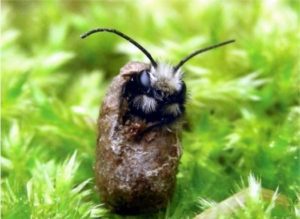Mason Bee Guide
How To successfully raise Stingless
Blue Mason Bees.
Visit our web site for informative articles, on mason bee and leafcutter bee management, the latest scientific research on all things on stingless bees.
To successfully raise Mason Bees you must provide, fruit trees or flowers (Mason Bees love wildflowers) a nest, a shelter, mud.
These are very easy to provide, for well under a hundred dollars, and that includes the Mason Bees. To raise Blue Mason Bees, you’ll need, only 15 minutes to set up.
You’ll need the following –
Flowers- Sometimes they call Mason Bees, “Orchard Bees” they love fruit blossoms and excel at pollinating all kinds of fruit.
In an almond grove in California, Mason Bees increased the yield, on a hundred-acre plot, by 800 pounds per acre, overusing honeybees; at $1.95 per pound, therefore the grower netted an extra $156,000, in short; they’ll do the same for your garden.

Mason Bees love fruit trees but are happy with and need flowers to sustain them between the blooming of your fruits, almost all flowers, especially wildflowers like dandelions. Wild mustard is another of their favorites. Our web site has a good selection of wildflowers that Mason Bees and Leafcutter bees thrive on.

Nesting blocks (a cleanable nesting block) is imperative. Every season they need clean nesting sites; cleaning, our nesting blocks, takes just minutes.
Spray your block and shelter with attractant, Mason Bees and Summer Leafcutter bees like to nest where it smells like home, where other bees are nesting.
MUD
It is very important to have mud within 15-25 feet of nesting spots or the bees will abandon the nest site.
If you have sandy soils, that don’t stick together when you squeeze them, add some organic garden soil from one of the box stores.
Shelter


An old coffee can will work, all the outer covering is for, is to protect the Hatching Tube and nesting holes from the weather. Face the opening of the shelter, towards the morning sun, your bees will sit on the lip and warm up in the morning, before they go to work.
We never seem to have enough bees.
Many of you preorder your Mason Bees; When your Hatching Tube, filled with your Blue Mason Bees arrive, from Rocky Pond-Nursery you can store them in your refrigerator, and they will hibernate till spring.

If you order Mason Bees after March 15th a few of the males may have already hatched, when you receive them, so, expect a few hatched bees with most of your bees still in their cocoons.
Take the Hatching Tube to your nest and pull off the tape and release the males, that have hatched, they will hang around for two to three weeks, so they can breed the females. You can leave your Hatching Tube there if daytime temperatures will hover at 50 degrees or more.
 If none of the bees have hatched yet, or the bees that haven’t hatched you can store them in your refrigerator, in a humidifier for up and until May 1st before putting them out. If you need to store your Mason Bees for longer than 30 days, put the cocoons in a humidifier.
If none of the bees have hatched yet, or the bees that haven’t hatched you can store them in your refrigerator, in a humidifier for up and until May 1st before putting them out. If you need to store your Mason Bees for longer than 30 days, put the cocoons in a humidifier.
 Then put Bee Humidifier in your refrigerator. Your refrigerator humidity is way too low, 10-15% humidity, your bee may dehydrate and die if storing them without a Bee-Humidifier for longer than 30 days. Our Bee-Humidifier maintains your cocoons at a constant 50-60% humidity, while in your refrigerator. You can store them up and until May 1st or when the daytime temperature is consistently 55 degrees or more.
Then put Bee Humidifier in your refrigerator. Your refrigerator humidity is way too low, 10-15% humidity, your bee may dehydrate and die if storing them without a Bee-Humidifier for longer than 30 days. Our Bee-Humidifier maintains your cocoons at a constant 50-60% humidity, while in your refrigerator. You can store them up and until May 1st or when the daytime temperature is consistently 55 degrees or more.
Mason Bees will work for 6-8 weeks. For longer pollination season stagger you’re your release date. For instance, release 20 bees on March 1st and another 20 April 1st. The same applies to summer leafcutter bees; start June 1st and go from there.
When you are ready, take the Hatching Tube to the nest and put the Hatching Tube, in the protective cover, in this example, a coffee can, remove the tape covering the exit hole.
If your temperature is consistently over 85 degrees or there is no mud you might want to switch to summer Leafcutter Bees.
For Instructions on winter storage and cleaning of Mason bees cocoons go to www.rockypondnursery.com and look on the drop-down menu under “Learn”



